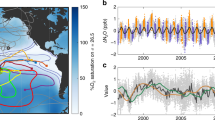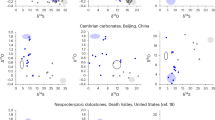Abstract
The atmospheric nitrous oxide mixing ratio has increased by 20% since 1750 (ref. 1). Given that nitrous oxide is both a long-lived greenhouse gas2 and a stratospheric ozone-depleting substance3, this increase is of global concern. However, the magnitude and geographic distribution of nitrous oxide sources, and how they have changed over time, is uncertain4,5. A key unknown is the influence of the stratospheric circulation4,5, which brings air depleted in nitrous oxide to the surface. Here, we report the oxygen and intramolecular nitrogen isotopic compositions of nitrous oxide in firn air samples from Antarctica and archived air samples from Cape Grim, Tasmania, spanning 1940–2005. We detect seasonal cycles in the isotopic composition of nitrous oxide at Cape Grim. The phases and amplitudes of these seasonal cycles allow us to distinguish between the influence of the stratospheric sink and the oceanic source at this site, demonstrating that isotope measurements can help in the attribution and quantification of surface sources in general. Large interannual variations and long-term decreasing trends in isotope composition are also apparent. These long-term trends allow us to distinguish between natural and anthropogenic sources of nitrous oxide, and confirm that the rise in atmospheric nitrous oxide levels is largely the result of an increased reliance on nitrogen-based fertilizers.
This is a preview of subscription content, access via your institution
Access options
Subscribe to this journal
Receive 12 print issues and online access
$259.00 per year
only $21.58 per issue
Buy this article
- Purchase on Springer Link
- Instant access to full article PDF
Prices may be subject to local taxes which are calculated during checkout



Similar content being viewed by others
References
MacFarling-Meure, C. et al. Law Dome CO2, CH4, and N2O ice core records extended to 2000 years BP. Geophys. Res. Lett. 33, L14810 (2006).
IPCC Climate Change 2007: The Physical Science Basis (eds Solomon, S. et al.) (Cambridge Univ. Press, 2007).
Ravishankara, A. R., Daniel, J. S. & Portman, R. W. Nitrous oxide (N2O): The dominant ozone-depleting substance emitted in the 21st century. Science 326, 123–125 (2009).
Hirsch, A. I. et al. Inverse modeling estimates of the global nitrous oxide surface flux from 1998–2001. Glob. Biogeochem. Cycles 20, GB1008 (2006).
Huang, J. et al. Estimation of regional emissions of nitrous oxide from 1997 to 2005 using multinetwork measurements, a chemical transport model, and an inverse method. J. Geophys. Res. 113, D17313 (2008).
Davidson, E. A. The contribution of manure and fertilizer nitrogen to atmospheric nitrous oxide since 1860. Nature Geosci. 2, 659–662 (2009).
Galloway, J. N. et al. Transformation of the nitrogen cycle: Recent trends, questions, and potential solutions. Science 320, 889–892 (2008).
Nevison, C. D. et al. Southern Ocean ventilation inferred from seasonal cycles of atmospheric N2O and O2/N2 at Cape Grim, Tasmania. Tellus 57, 218–229 (2005).
Nevison, C. D. et al. Exploring causes of interannual variability in the seasonal cycles of tropospheric nitrous oxide. Atmos. Chem. Phys. 11, 3713–3730 (2011).
Jiang, X. et al. Seasonal cycle of N2O: Analysis of data. Glob. Biogeochem. Cycles 21, GB1006 (2007).
Yoshida, N. & Toyoda, S. Constraining the atmospheric N2O budget from intramolecular site preference in N2O isotopomers. Nature 405, 330–334 (2000).
Kim, K-R. & Craig, H. Nitrogen-15 and oxygen-18 characteristics of nitrous oxide: A global perspective. Science 262, 1855–1857 (1993).
Pérez, T. et al. Identifying the agricultural imprint on the global N2O budget using stable isotopes. J. Geophys. Res. 106, 9869–9878 (2001).
Toyoda, S. et al. Characterization and production and consumption processes of N2O emitted from temperate agricultural soils determined via isotopomer ratio analysis. Glob. Biogeochem. Cycles 25, GB2008 (2011).
Yung, Y. L. & Miller, C. E. Isotopic fractionation of stratospheric nitrous oxide. Science 278, 1778–1780 (1997).
Röckmann, T., Brenninkmeijer, C. A. M., Wollenhaupt, M., Crowley, J. N. & Crutzen, P. J. Measurement of the isotopic fractionation of 15N14N16O, 14N15N16O and 14N14N18O in the UV photolysis of nitrous oxide. Geophys. Res. Lett. 27, 1399–1402 (2000).
McLinden, C. A., Prather, M. J. & Johnson, M. S. Global modeling of N2O isotopomers: Stratospheric enrichment, isotope-budgets and the 17O–18O mass-independent anomaly. J. Geophys. Res. 108, 4233 (2003).
Rahn, T. & Wahlen, M. A reassessment of the global isotopic budget of atmospheric nitrous oxide. Glob. Biogeochem. Cycles 14, 537–543 (2000).
Park, S., Atlas, E. L. & Boering, K. A. Measurements of N2O isotopologues in the stratosphere: Influence of transport on the apparent enrichment factors and the isotopologue fluxes to the troposphere. J. Geophys. Res. 109, D01305 (2004).
Sowers, T., Rodebaugh, A., Yoshida, N. & Toyoda, S. Extending the records of the isotopic composition of atmospheric N2O back to 1800 AD from firn air trapped in snow at the South Pole and the Greenland Ice Sheet Project II ice core. Glob. Biogeochem. Cycles 16, 1129–1138 (2002).
Röckmann, T., Kaiser, J. & Brenninkmeijer, C. A. M. The isotopic fingerprint of the pre-industrial and the anthropogenic N2O source. Atmos. Chem. Phys. 3, 315–323 (2003).
Bernard, S. et al. Constraints on N2O budget changes since pre-industrial time from new firn air and ice core isotope measurements. Atmos. Chem. Phys. 6, 493–503 (2006).
Ishijima, K. et al. Temporal variations of the atmospheric nitrous oxide concentration and its δ15N and δ18O for the latter half of the 20th century reconstructed from firn air analyses. J. Geophys. Res. 112, D03305 (2007).
Röckmann, T. & Levin, I. High-precision determination of the changing isotopic composition of atmospheric N2O from 1990 to 2002. J. Geophys. Res. 110, D21304 (2005).
Sutka, R. L. et al. Distinguishing nitrous oxide production from nitrification and denitrification on the basis of isotopomer abundances. Appl. Environ. Microbiol. 72, 638–644 (2006).
Popp, B. N. et al. Nitrogen and oxygen isotopomeric constraints on the origins and sea-to-air flux of N2O in the oligotrophic subtropical North Pacific gyre. Glob. Biogeochem. Cycles 16, 1064 (2002).
Yamagishi, H. et al. Role of nitrification and denitrification on the nitrous oxide cycle in the eastern tropical North Pacific and Gulf of California. J. Geophys. Res. 112, G02015 (2007).
Langenfelds, R. L. et al. Interannual growth rate variations of atmospheric CO2 and its δ13C, H2, CH4, and CO between 1992 and 1999 linked to biomass burning. Glob. Biogeochem. Cycles 16, 1048 (2002).
Simmonds, P. G. et al. A burning question. Can recent growth rate anomalies in the greenhouse gases be attributed to large-scale biomass burning events? Atmos. Environ. 39, 2513–2517 (2005).
Crutzen, P. J., Mosier, A. R., Smith, K. A. & Winiwarter, W. N2O release from agro-biofuel production negates global warming reduction by replacing fossil fuels. Atmos. Chem. Phys. 8, 389–395 (2008).
Acknowledgements
This work was supported by the UC Berkeley Atmospheric Sciences Center, the NASA Upper Atmosphere Research Program (NNX09AJ95G) and the Camille Dreyfus Teacher-Scholar Award (KAB) through UC Berkeley; the Brain Korea 21 Program and Korea NRF grant 2011-0013756 (S.P.) through the School of Earth and Environmental Sciences at Seoul National University; and the Australia Government’s Cooperative Research Centres Programme (T.D.v.O.). Long-term support by the Australian Government Bureau of Meteorology for the Cape Grim Air Archive Program is also gratefully acknowledged, and we are indebted to many Cape Grim staff for their diligent efforts in collecting the air archive samples. We thank S. Wofsy for comments on the analyses and manuscript and K-Y. Kim for additional insights from a cyclostationary empirical orthogonal function analysis of the data.
Author information
Authors and Affiliations
Contributions
S.P., P.C., and K.A.B. carried out the isotope measurements, analysed the results, interpreted the data and wrote the manuscript; P.C. developed and ran the box model, S.P. carried out the red-noise spectral calculations and both contributed equally to this work; R.L.L. and P.B.K. carried out the Cape Grim Air Archive time-series analyses; R.L.L., L.P.S., P.B.K. and P.J.F. provided air samples from the Cape Grim Air Archive, N2O mixing ratio measurements and manuscript comments. P.J.F., KRK, R.L.L. and L.P.S. proposed the study, gave conceptual advice and manuscript comments; D.M.E., D.F., C.M.T. and T.D.v.O. provided firn air samples and dating of those samples. C.M.T. modelled air movement in the firn and made the gravitational and diffusion corrections.
Corresponding author
Ethics declarations
Competing interests
The authors declare no competing financial interests.
Supplementary information
Supplementary Information
Supplementary Information (PDF 1064 kb)
Rights and permissions
About this article
Cite this article
Park, S., Croteau, P., Boering, K. et al. Trends and seasonal cycles in the isotopic composition of nitrous oxide since 1940. Nature Geosci 5, 261–265 (2012). https://doi.org/10.1038/ngeo1421
Received:
Accepted:
Published:
Issue Date:
DOI: https://doi.org/10.1038/ngeo1421
This article is cited by
-
Characteristics of atmospheric nitrous oxide observed at Mt. Waliguan GAW global station in the inland Eurasia during eighteen years
Science China Earth Sciences (2024)
-
Growth, Productivity, and Essential Oil Content of Fennel Plants Treated with Spirulina Platensis Extract and Compost Tea Under Low Nitrogen Doses
Gesunde Pflanzen (2023)
-
Soil Aggregate Size Distribution Alters CO2 but not N2O Emission Rates in Chinese Fir (Cunninghamia lanceolata) Plantations with N and P Additions
Journal of Soil Science and Plant Nutrition (2023)
-
Understory vegetation altered soil CO2 and N2O emissions and the correlation with plant and soil stoichiometry following N and P addition in Chinese fir plantations
Plant and Soil (2023)
-
Nanomaterials in agriculture for plant health and food safety: a comprehensive review on the current state of agro-nanoscience
3 Biotech (2023)



